Columns of Gediminas
| Columns of Gediminas Gediminids' Pillars | |
|---|---|
 | |
| Armiger | Grand Duchy of Lithuania, Republic of Lithuania, Sąjūdis |
| Adopted | It is certain that since 1397, the Gediminids' Pillars were Vytautas the Great's coat of arms. |
The Columns of Gediminas or Pillars of Gediminas (Lithuanian: Gediminaičių stulpai, lit. 'Pillars of the Gediminids'; Belarusian: Калюмны, romanized: Kaliumny, 'Columns') are one of the earliest symbols of Lithuania and its historical coats of arms.[1] They were used in the Grand Duchy of Lithuania, initially as a rulers' personal insignia, a state symbol, and later as a part of heraldic signs of leading aristocracy.[1]
Appearance
The symbol appears in the following form: Horizontal line at bottom, vertical lines extend up at both ends. The square at the middle of the horizontal line is about half as tall as the vertical lines. Another vertical line rises from the top center of the square, giving an overall appearance that is close to a trident. This form is the one usually seen in modern times, often drawn on walls and fences as protest against the Soviet occupation of Lithuania.
It is notable that the ancient pre-Christian symbols of Lithuania did not follow the same strict rules of heraldry as their Western counterparts. Thus this symbol was used in or and argent, usually on the field gules, and was depicted in various shapes on flags, banners and shields.
Some Belarusian historians claim that the Columns directly go back to the symbol of the Rurikids, which was the trident.[2]
Name
The name "Columns of Gediminas" was given in the 19th century by historian Teodor Narbutt, who supposed that the symbol was Gediminas' insignia. The more exact name of the symbol is the Pillars of Gediminids, since there is no direct evidence of its connection with Grand Duke of Lithuania Gediminas.
History
In the Grand Duchy of Lithuania
According to the historical and archaeological evidence, the Columns were used by Grand Duke of Lithuania and Duke of Trakai Kęstutis. They appear on the Lithuanian coins issued by him.[3] The symbol was also used by Vytautas as his personal insignia since 1397 and appeared on his seal and coins.[4] It was suggested by historian Edmundas Antanas Rimša, who analyzed the ancient coins, that the Columns of the Gediminids symbolizes the Gates of the Trakai Peninsula Castle.[5] According to the accounts of Jan Długosz, it was derived from a symbol or brand used to mark horses and other property. The Columns were adopted by descendants of Kęstutis as their family symbol, equivalent to a coat of arms. Another user of the Columns of Gediminas was Grand Duke of Lithuania Sigismund Kęstutaitis. At first, the Columns signified the family of Kęstutis, in contrast to the Vytis which was used by Algirdas' descendants. Later on, as a symbol of a ruling dynasty, it was adopted by Jagiellons and the two symbols became state symbols of the Grand Duchy of Lithuania and the Columns of Gediminas remained in use over the following centuries.
-
 Grand Duke Vytautas the Great coin of the Principality of Smolensk (minted in 1399–1401) with the Columns of the Gediminids and the Ruthenian lion or leopard.
Grand Duke Vytautas the Great coin of the Principality of Smolensk (minted in 1399–1401) with the Columns of the Gediminids and the Ruthenian lion or leopard. -
 Denarius of Vytautas, XV century
Denarius of Vytautas, XV century -
![Reconstruction of Vytautas' flag at the Battle of Grunwald[citation needed]](//upload.wikimedia.org/wikipedia/commons/thumb/e/e4/Alex_K_Grundwald_flags_1410-02.svg/120px-Alex_K_Grundwald_flags_1410-02.svg.png) Reconstruction of Vytautas' flag at the Battle of Grunwald[citation needed]
Reconstruction of Vytautas' flag at the Battle of Grunwald[citation needed] -
 Columns of Gediminas as drawn in an armorial by a Portuguese herald in the Council of Constance in 1416
Columns of Gediminas as drawn in an armorial by a Portuguese herald in the Council of Constance in 1416 -
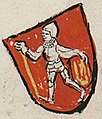 Coat of arms of Trakai Voivodeship with standing warrior and the Columns of Gediminas from the Codex Bergshammar, dating to ~1435.
Coat of arms of Trakai Voivodeship with standing warrior and the Columns of Gediminas from the Codex Bergshammar, dating to ~1435. -
 "Vytis" in the coat of arms Codex Bergshamar, circa 1440
"Vytis" in the coat of arms Codex Bergshamar, circa 1440 -
 From Łaski's Statute. 1506.
From Łaski's Statute. 1506. -
 Columns of Gediminas from Marcin Bielski's book Kronika Polska, 1597.
Columns of Gediminas from Marcin Bielski's book Kronika Polska, 1597. -
 Coat of arms of Lithuania Vytis (Waykimas) with Columns of Gediminas, painted in the 15th century Wernigerode Armorial. Attributed to Vytautas the Great.
Coat of arms of Lithuania Vytis (Waykimas) with Columns of Gediminas, painted in the 15th century Wernigerode Armorial. Attributed to Vytautas the Great. -
 Vytis (Waykimas) with the Columns of Gediminas, used during the reign of the Grand Duke of Lithuania Stephen Báthory in the 16th century.
Vytis (Waykimas) with the Columns of Gediminas, used during the reign of the Grand Duke of Lithuania Stephen Báthory in the 16th century. -
 "Seal of Polotsk" on the big seal of Ivan the Terrible. 16th century
"Seal of Polotsk" on the big seal of Ivan the Terrible. 16th century -
 Coin of Sigismund II Augustus
Coin of Sigismund II Augustus -
 Seal of King and Grand Duke Augustus III, 1738
Seal of King and Grand Duke Augustus III, 1738 -
 From the genealogy of the princes Radziwill, 1742
From the genealogy of the princes Radziwill, 1742 -
 Great Lithuanian seal of Stanisław August Poniatowski, 1764
Great Lithuanian seal of Stanisław August Poniatowski, 1764 -
 Columns from the Castle Church in Kodno (Poland), 1885
Columns from the Castle Church in Kodno (Poland), 1885 -
 Engraving of Pillars of Gediminas on a stone on Rambynas hill
Engraving of Pillars of Gediminas on a stone on Rambynas hill
In the Interwar Republic of Lithuania
During the period between World War I and World War II they were used by the Lithuanian Republic as a major state symbol, e. g. on Litas coins, monuments and military equipment. The Columns of Gediminas are featured on the Lithuanian Presidential Award Order of the Lithuanian Grand Duke Gediminas, which was started in 1928.
-
 Flag of the Šiauliai branch of the Lithuanian Armed Forces Creators Volunteers Union (1918–1920).
Flag of the Šiauliai branch of the Lithuanian Armed Forces Creators Volunteers Union (1918–1920). -
 Lithuanian coin of 5 cents with Vytis (Waykimas) and the Columns of Gediminas, 1925.
Lithuanian coin of 5 cents with Vytis (Waykimas) and the Columns of Gediminas, 1925. -
 Lithuania 100 litas 1928
Lithuania 100 litas 1928 -
 Banknote (reverse) of 2 Lithuanian litas with the Columns of Gediminas, 16 November 1922 edition.
Banknote (reverse) of 2 Lithuanian litas with the Columns of Gediminas, 16 November 1922 edition. -
 An arc decorated with the Columns of the Gediminids during the unveiling ceremony of the Monument of 10th anniversary of Independence of Lithuania in Rokiškis (1931)
An arc decorated with the Columns of the Gediminids during the unveiling ceremony of the Monument of 10th anniversary of Independence of Lithuania in Rokiškis (1931) -
 A Lithuanian scout Liudas Tarabilda with a model of the Gediminas Tower (a campaign of the Union for the Liberation of Vilnius) in the yard of his school in Anykščiai (1932)
A Lithuanian scout Liudas Tarabilda with a model of the Gediminas Tower (a campaign of the Union for the Liberation of Vilnius) in the yard of his school in Anykščiai (1932) -
 Old Bank of Lithuania building with Vytis (Waykimas) and the Columns of Gediminas in Kaunas, created in 1927.
Old Bank of Lithuania building with Vytis (Waykimas) and the Columns of Gediminas in Kaunas, created in 1927. -
 Ministry of Finance of Lithuania with portraits of Antanas Smetona, Vytautas the Great, Vytis (Waykimas) and the Columns of Gediminas in Kaunas, 1930.
Ministry of Finance of Lithuania with portraits of Antanas Smetona, Vytautas the Great, Vytis (Waykimas) and the Columns of Gediminas in Kaunas, 1930. -
 Mauser rifles of the Lithuanian Army marked with Columns of Gediminas, 1924.
Mauser rifles of the Lithuanian Army marked with Columns of Gediminas, 1924. -
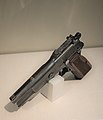 Browning Hi-Power of the Lithuanian Army marked with Columns of Gediminas, 1935.
Browning Hi-Power of the Lithuanian Army marked with Columns of Gediminas, 1935. -
 Flag of Lithuanian Sailing Union (1935-1940)
Flag of Lithuanian Sailing Union (1935-1940) -
 Lithuanian Art Museum in Radviliškis 1938.
Lithuanian Art Museum in Radviliškis 1938. -
 Lithuanian cadets near a War School in Kaunas, 1938.
Lithuanian cadets near a War School in Kaunas, 1938. -
 Lithuanian Vickers 4-ton tanks marked with Columns of Gediminas head to Vilnius 1939.
Lithuanian Vickers 4-ton tanks marked with Columns of Gediminas head to Vilnius 1939. -
 Residents of Vilnius greet Lithuanian tanks decorated with Columns of Gediminas in the Cathedral Square in Vilnius in 1939
Residents of Vilnius greet Lithuanian tanks decorated with Columns of Gediminas in the Cathedral Square in Vilnius in 1939
In the Soviet Union
After the annexation of Lithuania by the Soviet Union, the symbol was officially banned. During the Singing Revolution of the late 80s, it became the iconic sign of the reform movement Sąjūdis.
Modern usage in Lithuania
The Columns of Gediminas appears in the coat of arms of Seimas and in the emblems of the Lithuanian Armed Forces, Land Force, Air Force, Navy, Military Police, National Defence Volunteer Forces and Grand Duke Gediminas Staff Battalion. The Columns of Gediminas are also featured in the coat of arms of Old Trakai, Trakai District Municipality and Šimkaičiai. The symbol is also used on many monuments throughout the country.
- Use of the Columns of Gediminas in modern Lithuania
-
 Coat of arms of the Seimas of Lithuania
Coat of arms of the Seimas of Lithuania -
 Coat of arms of Old Trakai.
Coat of arms of Old Trakai. -
 Coat of arms of Trakai District Municipality
Coat of arms of Trakai District Municipality -
 Coat of arms of Šimkaičiai
Coat of arms of Šimkaičiai -
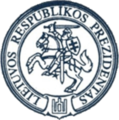 Presidential seal of Lithuania
Presidential seal of Lithuania -

-
 Columns of Gediminas in the yellow room at Palace of the Grand Dukes of Lithuania in Vilnius.
Columns of Gediminas in the yellow room at Palace of the Grand Dukes of Lithuania in Vilnius. - Monument to Vincas Kudirka in Vilnius is topped by Columns of Gediminas.
-
 Monument to Zygmunt Sierakowski and Kastus Kalinowski with Columns of Gediminas.
Monument to Zygmunt Sierakowski and Kastus Kalinowski with Columns of Gediminas. - Monument to Vytautas the Great in Kernavė with Columns of Gediminas.
-
 Monument with the Columns of Gediminas, dedicated to the 10th anniversary of Independence of Lithuania in Plungė.
Monument with the Columns of Gediminas, dedicated to the 10th anniversary of Independence of Lithuania in Plungė. -
 Monument with the Columns of Gediminas, dedicated to the Lithuanian Wars of Independence in Joniškis.
Monument with the Columns of Gediminas, dedicated to the Lithuanian Wars of Independence in Joniškis. -
 The Three Giants (Trys Milžinai) symbol in Kaunas.
The Three Giants (Trys Milžinai) symbol in Kaunas. -
 Simonas Daukantas Bridge in Kaunas with the Columns of the Gediminas on top.
Simonas Daukantas Bridge in Kaunas with the Columns of the Gediminas on top. -
 Grand Duke Kęstutis monument with Columns of Gediminas in Prienai.
Grand Duke Kęstutis monument with Columns of Gediminas in Prienai. -
 Monument with Columns of Gediminas in the Cemetery of Lithuanian soldiers in Kupiškis.
Monument with Columns of Gediminas in the Cemetery of Lithuanian soldiers in Kupiškis. -
 Monument ot Lithuanian Independence with Columns of Gediminas in Senoji Varėna.
Monument ot Lithuanian Independence with Columns of Gediminas in Senoji Varėna. - Gymnasium of Vytautas the Great in Klaipėda with Columns of Gediminas on its roof.
- Use of the Columns of Gediminas in modern Lithuanian Army
-
 By the Lithuanian Armed Forces.
By the Lithuanian Armed Forces. -
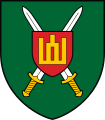 By the Lithuanian Land Force.
By the Lithuanian Land Force. -
 By the Lithuanian Air Force.
By the Lithuanian Air Force. -
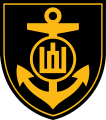 By the Lithuanian Naval Force.
By the Lithuanian Naval Force. -
 By the Lithuanian Military Police.
By the Lithuanian Military Police. -

-
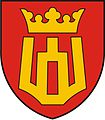
-
 Flag of the Lithuanian Armed Forces, reverse side.
Flag of the Lithuanian Armed Forces, reverse side. -
 Flag of the Lithuanian Military Police.
Flag of the Lithuanian Military Police. -
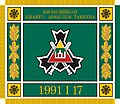 Flag of the Lithuanian National Defence Volunteer Forces.
Flag of the Lithuanian National Defence Volunteer Forces. -
 Flag of the Lithuanian Grand Duke Gediminas Staff Battalion.
Flag of the Lithuanian Grand Duke Gediminas Staff Battalion. -
 Columns of Gediminas are widely used on Lithuanian military vehicles.
Columns of Gediminas are widely used on Lithuanian military vehicles.
The official logo of the EuroBasket 2011, which took place in Lithuania, is composed of the Columns overlaid on a basketball board.
The Columns of Gediminas with post horn are also the official logo of the Lithuanian postal company — Lietuvos paštas. The company uses the columns on its official stamps.[6]
A combination of the Columns of Gediminas and the Menorah are used by the Litvak community as a symbol meant to identify Lithuanian Jews with content expressing the history of the Jews in Lithuania.[7]
Usage in Belarus

1. The symbol of Prince Izyaslav of Polotsk, Gules, on an argent field;
2. Columns of Gediminas, Argent on a gules field;
3. Coat of arms of Kaributas, Or, on a azure field.[8]
In modern Belarus, the columns of Gediminas, alongside the Pahonia, are occasionally used as a symbol of national pride.[9][10][11][12]
The columns of Gediminas are in the coat of arms of Brahin in southeastern Belarus.[8]
The symbol is featured on the monument to the Grand Duke Gediminas in Lida. which was unveiled in 2019.[13]
Usage in Ukraine
In Ukraine, the coat of arms of Zhytomyr Oblast adopted an archaic form of the Vytis (Pohonia) on the second quarter, with the Columns of Gediminas on knight's shield.[14][15]
After the 2022 Russian invasion of Ukraine started, the Pahonia Regiment was formed as part of the International Legion of Territorial Defence of Ukraine, which used the Columns of Gediminas on their emblem.
-
 Coat of arms of Zhytomyr Oblast
Coat of arms of Zhytomyr Oblast -
![White-red-white flag with Columns of Gediminas in the form of a trident of the Belarusian diaspora in Ukraine, which is also used by the Kastuś Kalinoŭski Regiment[16][17]](//upload.wikimedia.org/wikipedia/commons/thumb/0/0e/White-red-white_flag_of_the_Belarusian_diaspora_in_Ukraine.svg/120px-White-red-white_flag_of_the_Belarusian_diaspora_in_Ukraine.svg.png) White-red-white flag with Columns of Gediminas in the form of a trident of the Belarusian diaspora in Ukraine, which is also used by the Kastuś Kalinoŭski Regiment[16][17]
White-red-white flag with Columns of Gediminas in the form of a trident of the Belarusian diaspora in Ukraine, which is also used by the Kastuś Kalinoŭski Regiment[16][17] -
 The Columns of Gediminas on the emblem of the Pahonia Regiment
The Columns of Gediminas on the emblem of the Pahonia Regiment -
 Emblem of the 1st separate amphibious assault company "Belarus"
Emblem of the 1st separate amphibious assault company "Belarus"
In art
The Columns of Gediminas are displayed at Battle of Grunwald by Jan Matejko.
-
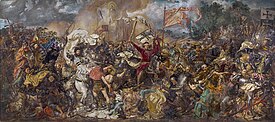 The columns of Gediminas are displayed on the flag to the left of Vytautas the Great
The columns of Gediminas are displayed on the flag to the left of Vytautas the Great
See also

- Coat of arms of Lithuania
- Gediminas' Tower
- House of Gediminas
- Polish heraldry
- Symbols of the Rurikids
- Tamga
References
- ^ a b "Columns of the Gediminids". Seimas. Retrieved 4 June 2021.
- ^ Вяроўкін-Шэлюта, У. (2005). "Калюмны". Вялікае Княства Літоўскае. Энцыклапедыя у 3 т. [Grand Duchy of Lithuania. Encyclopedia in 3 vols.] (in Belarusian). Vol. 2. Minsk: BelEn. p. 21. ISBN 985-11-0378-0.
- ^ (in Lithuanian) Peculiarities of earliest Lithuanian coins
- ^ (in Lithuanian) Vilniaus Žemutinės pilies lobis – XIV a. pabaigos valstybinių bei valdovų atributų atspindys
- ^ Savukynas, Virginijus. "Kas slypi už tautinių simbolių?". DELFI (in Lithuanian). Prepared according to V. Savukynas telecast Tapatybės labirintai. Retrieved 3 April 2021.
- ^ "Pirmieji 2018 metų pašto ženklai bus pažymėti Gediminaičių stulpais(In Lithuanian)". old.post.lt/en. 3 January 2018.
- ^ "The Columns of Gediminas: Symbol of Lithuanian Statehood". lzb.lt. 25 November 2019.
- ^ a b "Геральдыка" [Heraldry]. Brahin District Executive Committee (in Belarusian).
- ^ Свабода, Радыё (2014-09-05). "Крыж, Пагоня ці Калюмны — які сымбаль яднае беларусаў? (галасаванка)" [Cross, Pursuit or Columns - which symbol unites Belarusians? (ballot)]. Радыё Свабода (in Belarusian).
- ^ "На Дзень Волі – у цішотцы з «Пагоняй» ад Віталя Гуркова" [On Freedom Day - in a t-shirt with "Chase" by Vitaly Gurkov]. Belsat (in Belarusian). 2017-03-08.
Мы хочам, каб Пагоня, Калюмны, магдэбургскія гербы гарадоў і мястэчак – багацце геральдычнай спадчыны нашага краю – сталі часткай культурнага кантэксту Беларусі.
- ^ "«Первые свитшоты я распродал за час возле метро». Чем выделился этот бренд — история LSTR Adziennie" ["I sold out my first sweatshirts in an hour near the subway." What made this brand stand out - the history of LSTR Adziennie]. PROBUSINESS.IO (in Russian). 2018-06-04.
- ^ Еўрарадыё (2018-05-28). "Партыю дызайнерскіх лідскіх красовак раскупілі за паўдня" [A lot of designer Lida sneakers were sold out in half a day]. European Radio for Belarus. Archived from the original on 2018-08-09.
- ^ Еврорадио (2019-09-07). "В Лиде торжественно открыли памятник Гедимину" [A monument to Gediminas was solemnly unveiled in Lida]. Euroradio.fm (in Russian). Archived from the original on 2019-10-01.
- ^ "Zhytomir County (Ukraine)". Flags of the World. Retrieved 2023-04-02.
- ^ "Сучасні символи областей України". Ukrainian Heraldry Society (in Ukrainian). Retrieved 2023-04-02.
- ^ "Білоруси створили в Україні "Білоруський Добровольчий Корпус"". Мілітарний (in Ukrainian). Retrieved 2022-12-26.
- ^ Журавель, Дмитро (2022-12-26). "В Україні з'явився «Білоруський Добровольчий Корпус» (ВІДЕО)". ШоТам (in Ukrainian). Retrieved 2022-12-26.
Sources
- Valstybė. Iliustruota Lietuvos enciklopedija
- "Gediminas' Columns". Encyclopedia Lituanica II: 293. (1970–1978). Ed. Simas Sužiedėlis. Boston, Massachusetts: Juozas Kapočius. LCCN 74–114275.


![Reconstruction of Vytautas' flag at the Battle of Grunwald[citation needed]](http://upload.wikimedia.org/wikipedia/commons/thumb/e/e4/Alex_K_Grundwald_flags_1410-02.svg/120px-Alex_K_Grundwald_flags_1410-02.svg.png)




























































![White-red-white flag with Columns of Gediminas in the form of a trident of the Belarusian diaspora in Ukraine, which is also used by the Kastuś Kalinoŭski Regiment[16][17]](http://upload.wikimedia.org/wikipedia/commons/thumb/0/0e/White-red-white_flag_of_the_Belarusian_diaspora_in_Ukraine.svg/120px-White-red-white_flag_of_the_Belarusian_diaspora_in_Ukraine.svg.png)














